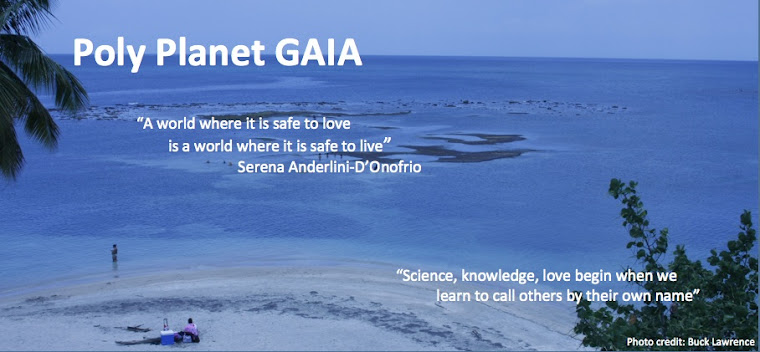Dear Earthlings:
The
EcoSex course at U Conn is in process. It's a great experience. We
are reading amazing books. Thinking out of the box and across
disciplines. Students are sending their responses in, with discussion
questions. In class, we connect the dots: a
holograph of what we've read together, the "required readings."
Multiple perspectives and good synergy. Here, we offer a glimpse.
Lynn Margulis and Dorion Sagan's Mystery Dance was one of two theory-of-science books. We got four responses: from John, Alissa, Rhiann, Adam, and Michael.
Here's Adam's take:
Response to Lynn Margulis and Dorion Sagan's Mystery Dance: On the Evolution of Human Sexuality
I thoroughly enjoyed “Mystery Dance” by Lynn Margulis and
Dorion Sagan. These women proved to me, once again, that they are competent,
brilliant story-tellers, as well as scientists. I was captivated from the
start; the interdisciplinary nature of the book, touching on biology, feminist
perspectives, paleontology, microbiology, psychology, etc. appealed to my
intellect and made it impossible to label the book as too one-sided or bland.
As an evolutionary biology major, I am fascinated by any
news or information on evolution and all the process entails. “Mystery Dance” took an approach to the
concept of evolution that I had not deeply considered before; the ‘stripper’
motive endowed the concept of evolution with an air of sexuality and, just as
importantly, layers. As a child, I viewed evolution like links in a chain –
mutations that resulted in the beginning or end of a species. As I have grown,
I have learned that evolution if far less cut and dry than that, and this book
articulates that superbly.
Another thing I loved about this book was how Margulis
and Sagan focus on the human sex organs, and their relation, in comparison, to
our fellow primates and, more broadly, to the other species in the various
kingdoms and phylum. I had a decent understanding of these concepts before my
reading of this book; I had done my own novice research because of interest on
the subject. However, “Mystery Dance”
took what I already knew and vastly expanded upon it. Why female Homo sapiens
have permanently distended breasts after puberty, why male Homo sapiens
generally have much larger genitalia than those of our fellow primates, how we
associate sex with the primal, and therefore uncontrollable, dirty parts of our
bodies – all are questions that I did not even know I had, now answered.
My question: Looking at current trends, can one predict
how human sexual physiology will change in the future, assuming we continue
existing as a species?
Adam Kocurek
Published with permission
WGSS 3998 - Ecosexuality and the Ecology of Love
Prof. Serena Anderlini-D'Onofrio
U Conn, Storrs, Spring 2013
Dear Earthlings:
Let "nature" be your teacher in the arts of love. Education is the heart of democracy, education to love. Come
back for more wonders: Students Responses to appear every Tuesday.
Book Reports to be scheduled soon, every other Thursday. Check out our summer offerings: Ecosexuality in Portland, OR, July 17-21. Info and Registration here!
Namaste,
Serena Anderlini-D'Onofrio, PhD
Gilf Gaia Extraordinaire
University of Puerto Rico, Mayaguez
Follow us in the social media
Poly Planet GAIA Blog:
http://polyplanet.blogspot.
http://polyplanet.blogspot.
Website: www.serenagaia.com
Be Appraised of Ecosex Community Project PostaHouse
Become a Fan: www.facebook.com/GaiaBlessings
Author's Page/Lists all books:
YouTube Uploaded Videos: http://www.youtube.com/











